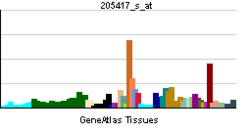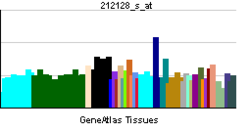- Dystroglycan
-
Dystroglycan is a protein that in humans is encoded by the DAG1 gene.[1][2][3]
Dystroglycan is one of the dystrophin-associated glycoproteins, which is encoded by a 5.5 kb transcript in Homo sapiens by chromosome 3.[4] There are two exons that are separated by a large intron. The spliced exons codes for a protein product is finally cleaved into two non-covalently associated subunits, [alpha] (N-terminal) and [beta] (C-terminal).
Contents
Function
In skeletal muscle the dystroglycan complex works as a transmembrane linkage between the extracellular matrix and the cytoskeleton. [alpha]-dystroglycan is extracellular and binds to merosin [alpha]-2 laminin in the basement membrane, while [beta]-dystroglycan is a transmembrane protein and binds to dystrophin, which is a large rod-like cytoskeletal protein, absent in Duchenne muscular dystrophy patients. Dystrophin binds to intracellular actin cables. In this way, the dystroglycan complex, which links the extracellular matrix to the intracellular actin cables, is thought to provide structural integrity in muscle tissues. The dystroglycan complex is also known to serve as an agrin receptor in muscle, where it may regulate agrin-induced acetylcholine receptor clustering at the neuromuscular junction. There is also evidence which suggests the function of dystroglycan as a part of the signal transduction pathway because it is shown that Grb2, a mediator of the Ras-related signal pathway, can interact with the cytoplasmic domain of dystroglycan.
Expression
Dystroglycan is widely distributed in non-muscle tissues as well as in muscle tissues. During epithelial morphogenesis of kidney, the dystroglycan complex is shown to act as a receptor for the basement membrane. Dystroglycan expression in Mus musculus brain and neural retina has also been reported. However, the physiological role of dystroglycan in non-muscle tissues has remained unclear
Interactions
Dystroglycan has been shown to interact with FYN,[5] C-src tyrosine kinase,[5] Src,[5] NCK1,[5] Grb2,[6] Caveolin 3[7] and SHC1.[5]
See also
References
- ^ Skynner MJ, Gangadharan U, Coulton GR, Mason RM, Nikitopoulou A, Brown SD, Blanco G (Jul 1995). "Genetic mapping of the mouse neuromuscular mutation kyphoscoliosis". Genomics 25 (1): 207–13. doi:10.1016/0888-7543(95)80127-8. PMID 7774920.
- ^ Ibraghimov-Beskrovnaya O, Ervasti JM, Leveille CJ, Slaughter CA, Sernett SW, Campbell KP (Mar 1992). "Primary structure of dystrophin-associated glycoproteins linking dystrophin to the extracellular matrix". Nature 355 (6362): 696–702. doi:10.1038/355696a0. PMID 1741056.
- ^ "Entrez Gene: DAG1 dystroglycan 1 (dystrophin-associated glycoprotein 1)". http://www.ncbi.nlm.nih.gov/sites/entrez?Db=gene&Cmd=ShowDetailView&TermToSearch=1605.
- ^ Spence HJ, Dhillon AS, James M, Winder SJ (2004). "Dystroglycan, a scaffold for the ERK–MAP kinase cascade". EMBO Rep. 5 (5): 484–9. doi:10.1038/sj.embor.7400140. PMC 1299052. PMID 15071496. http://www.pubmedcentral.nih.gov/articlerender.fcgi?tool=pmcentrez&artid=1299052.
- ^ a b c d e Sotgia, F; Lee H, Bedford M T, Petrucci T, Sudol M, Lisanti M P (Dec. 2001). "Tyrosine phosphorylation of beta-dystroglycan at its WW domain binding motif, PPxY, recruits SH2 domain containing proteins". Biochemistry (United States) 40 (48): 14585–92. doi:10.1021/bi011247r. ISSN 0006-2960. PMID 11724572.
- ^ Yang, B; Jung D, Motto D, Meyer J, Koretzky G, Campbell K P (May. 1995). "SH3 domain-mediated interaction of dystroglycan and Grb2". J. Biol. Chem. (UNITED STATES) 270 (20): 11711–4. doi:10.1074/jbc.270.20.11711. ISSN 0021-9258. PMID 7744812.
- ^ Sotgia, F; Lee J K, Das K, Bedford M, Petrucci T C, Macioce P, Sargiacomo M, Bricarelli F D, Minetti C, Sudol M, Lisanti M P (Dec. 2000). "Caveolin-3 directly interacts with the C-terminal tail of beta -dystroglycan. Identification of a central WW-like domain within caveolin family members". J. Biol. Chem. (UNITED STATES) 275 (48): 38048–58. doi:10.1074/jbc.M005321200. ISSN 0021-9258. PMID 10988290.
Further reading
- Matsumura K, Tomé FM, Collin H, et al. (1992). "Deficiency of the 50K dystrophin-associated glycoprotein in severe childhood autosomal recessive muscular dystrophy". Nature 359 (6393): 320–2. doi:10.1038/359320a0. PMID 1406935.
- Apel ED, Roberds SL, Campbell KP, Merlie JP (1995). "Rapsyn may function as a link between the acetylcholine receptor and the agrin-binding dystrophin-associated glycoprotein complex". Neuron 15 (1): 115–26. doi:10.1016/0896-6273(95)90069-1. PMID 7619516.
- Yang B, Jung D, Motto D, et al. (1995). "SH3 domain-mediated interaction of dystroglycan and Grb2". J. Biol. Chem. 270 (20): 11711–4. doi:10.1074/jbc.270.20.11711. PMID 7744812.
- Yamada H, Shimizu T, Tanaka T, et al. (1994). "Dystroglycan is a binding protein of laminin and merosin in peripheral nerve". FEBS Lett. 352 (1): 49–53. doi:10.1016/0014-5793(94)00917-1. PMID 7925941.
- Gee SH, Montanaro F, Lindenbaum MH, Carbonetto S (1994). "Dystroglycan-alpha, a dystrophin-associated glycoprotein, is a functional agrin receptor". Cell 77 (5): 675–86. doi:10.1016/0092-8674(94)90052-3. PMID 8205617.
- Ibraghimov-Beskrovnaya O, Milatovich A, Ozcelik T, et al. (1994). "Human dystroglycan: skeletal muscle cDNA, genomic structure, origin of tissue specific isoforms and chromosomal localization". Hum. Mol. Genet. 2 (10): 1651–7. doi:10.1093/hmg/2.10.1651. PMID 8268918.
- Yamada H, Denzer AJ, Hori H, et al. (1996). "Dystroglycan is a dual receptor for agrin and laminin-2 in Schwann cell membrane". J. Biol. Chem. 271 (38): 23418–23. doi:10.1074/jbc.271.38.23418. PMID 8798547.
- Tian M, Jacobson C, Gee SH, et al. (1997). "Dystroglycan in the cerebellum is a laminin alpha 2-chain binding protein at the glial-vascular interface and is expressed in Purkinje cells". Eur. J. Neurosci. 8 (12): 2739–47. doi:10.1111/j.1460-9568.1996.tb01568.x. PMID 8996823.
- Matsumura K, Chiba A, Yamada H, et al. (1997). "A role of dystroglycan in schwannoma cell adhesion to laminin". J. Biol. Chem. 272 (21): 13904–10. doi:10.1074/jbc.272.21.13904. PMID 9153251.
- Pirozzi G, McConnell SJ, Uveges AJ, et al. (1997). "Identification of novel human WW domain-containing proteins by cloning of ligand targets". J. Biol. Chem. 272 (23): 14611–6. doi:10.1074/jbc.272.23.14611. PMID 9169421.
- Gesemann M, Brancaccio A, Schumacher B, Ruegg MA (1998). "Agrin is a high-affinity binding protein of dystroglycan in non-muscle tissue". J. Biol. Chem. 273 (1): 600–5. doi:10.1074/jbc.273.1.600. PMID 9417121.
- Rambukkana A, Yamada H, Zanazzi G, et al. (1998). "Role of alpha-dystroglycan as a Schwann cell receptor for Mycobacterium leprae". Science 282 (5396): 2076–9. doi:10.1126/science.282.5396.2076. PMID 9851927.
- Cao W, Henry MD, Borrow P, et al. (1998). "Identification of alpha-dystroglycan as a receptor for lymphocytic choriomeningitis virus and Lassa fever virus". Science 282 (5396): 2079–81. doi:10.1126/science.282.5396.2079. PMID 9851928.
- Shimizu H, Hosokawa H, Ninomiya H, et al. (1999). "Adhesion of cultured bovine aortic endothelial cells to laminin-1 mediated by dystroglycan". J. Biol. Chem. 274 (17): 11995–2000. doi:10.1074/jbc.274.17.11995. PMID 10207021.
- Côté PD, Moukhles H, Lindenbaum MH, Carbonetto S (1999). "Chimaeric mice deficient in dystroglycans develop muscular dystrophy and have disrupted myoneural synapses". Nat. Genet. 23 (3): 338–42. doi:10.1038/15519. PMID 10610181.
- Rentschler S, Linn H, Deininger K, et al. (1999). "The WW domain of dystrophin requires EF-hands region to interact with beta-dystroglycan". Biol. Chem. 380 (4): 431–42. doi:10.1515/BC.1999.057. PMID 10355629.
- Tommasi di Vignano A, Di Zenzo G, Sudol M, et al. (2000). "Contribution of the different modules in the utrophin carboxy-terminal region to the formation and regulation of the DAP complex". FEBS Lett. 471 (2–3): 229–34. doi:10.1016/S0014-5793(00)01400-9. PMID 10767429.
- James M, Nuttall A, Ilsley JL, et al. (2000). "Adhesion-dependent tyrosine phosphorylation of (beta)-dystroglycan regulates its interaction with utrophin". J. Cell. Sci. 113 ( Pt 10): 1717–26. PMID 10769203.
- Russo K, Di Stasio E, Macchia G, et al. (2000). "Characterization of the beta-dystroglycan-growth factor receptor 2 (Grb2) interaction". Biochem. Biophys. Res. Commun. 274 (1): 93–8. doi:10.1006/bbrc.2000.3103. PMID 10903901.
PDB gallery External links
- MeSH Dystroglycans
- Overview at sdbonline.org
- http://www.neuro.wustl.edu/neuromuscular/musdist/dag2.htm#ad
Proteins of the cytoskeleton Human I (MYO1A, MYO1B, MYO1C, MYO1D, MYO1E, MYO1F, MYO1G, MYO1H) · II (MYH1, MYH2, MYH3, MYH4, MYH6, MYH7, MYH7B, MYH8, MYH9, MYH10, MYH11, MYH13, MYH14, MYH15, MYH16) · III (MYO3A, MYO3B) · V (MYO5A, MYO5B, MYO5C) · VI (MYO6) · VII (MYO7A, MYO7B) · IX (MYO9A, MYO9B) · X (MYO10) · XV (MYO15A) · XVIII (MYO18A, MYO18B) · LC (MYL1, MYL2, MYL3, MYL4, MYL5, MYL6, MYL6B, MYL7, MYL9, MYLIP, MYLK, MYLK2, MYLL1)OtherOtherEpithelial keratins
(soft alpha-keratins)Hair keratins
(hard alpha-keratins)Ungrouped alphaNot alphaType 3Type 4Type 5OtherOtherNonhuman Histology: muscle tissue (TH H2.00.05, H3.3) Smooth
muscleStriated
muscleCostamere/
DAPCMembrane/
extracellularIntracellularDystrophin · Dystrobrevin (A, B) · Syntrophin (A, B1, B2, G1, G2) · Syncoilin · Dysbindin · Synemin/desmuslin
related: NOS1 · Caveolin 3GeneralNeuromuscular junction · Motor unit · Muscle spindle · Excitation-contraction coupling · Sliding filament mechanismBothFiberCellsOtherOther/
ungroupedCategories:- Human proteins
- Cell biology stubs
- Glycoproteins
Wikimedia Foundation. 2010.




